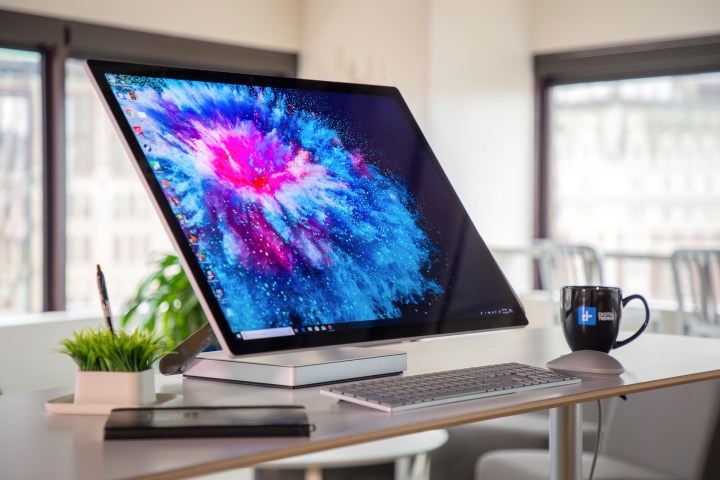It’s one again the most wonderful time of year to be a fan of new technology. “Techtober” is nearly upon us. Microsoft’s annual Surface hardware event is part of the cavalcade of new devices that get announced in the fall.
From a smaller 12.5-inch Surface Laptop, a followup to the Surface Pro X, here’s a look at everything you need to know about what Microsoft could announce.
When the Surface hardware event will be

Microsoft hasn’t officially announced its hardware event yet. But following similarly timed events from Apple and Google, every fall, Microsoft typically holds a dedicated hardware event where it releases new Surface hardware.
Usually, that event is held in person, in New York City, around late October. For the past two years, the event has been held on October 2, which would fall on a Friday this year.
Of course, we expect the event to be an all virtual affair, as Microsoft has announced all of its events through mid-2021 will be held online only.
Surface Pro X 2

First on the list of what to expect is the follow-up to last year’s Surface Pro X. Of course, we don’t know much about what this 2-in-1 will officially be called, but the latest rumors indicate that Microsoft will be releasing an updated model this fall. A Surface event will be the perfect time to show it off.
It is currently rumored that the next Surface Pro X model won’t be visually much different from the last. It reportedly will share the same slim and light design but will come in a new platinum color. The Type Cover accessory that can be purchased separately with the device, meanwhile, could also come in new colors to match what’s available on the rest of the Surface Pro X lineup.
Internally, the next Surface Pro X is rumored to have a new custom Microsoft SQ2 processor. This processor is based on the recently announced Qualcomm Snapdragon 8cX Gen 2. It will deliver added power efficiency, improved performance benefits, and the addition of 5G support.
Microsoft could also be working to tweak Windows 10 to improve app compatibility for the Surface Pro X, too. Windows Central reported that the company is working on 64-bit app emulation for Windows 10 on ARM devices. This fixes the problem from the original Surface Pro X, which only emulates 32-bit apps.
Affordable 12.5-inch Surface Laptop

Also expected from Microsoft this year is a 12.5-inch Surface Laptop. Judging from rumors, if the Surface Pro X followup is one hint, it could be that this 12.5-inch Surface Laptop might launch alongside a refreshed Surface Pro X model at a fall Surface event.
Much like the Surface Go 2 from earlier in 2019, this 12.5-inch Surface Laptop is apparently all about affordability. It is rumored to cost $600 and could take a lot of design elements from the larger 13- and 15-inch Surface Laptop models, but in a smaller package.
That is, keep the metal or Alcantara fabric finish, touchscreen, and thicker bezels around the screen, but shrink the overall design so it fits a 12.5-inch screen. According to Microsoft blogger Paul Thurrott, the device might not even come with a Windows Hello IR webcam and might instead feature a fingerprint reader.
The device is reportedly code-named Sparti and Windows Central reported that the entry-level model could come with a 10th-generation Core i5 Intel Ice Lake Processor, 4GB of RAM, and 64GB of storage space.
Priced between $500 and $600, this Surface Laptop model could shape up to be considerably cheaper than the $1,000 starting price of the current Surface Laptop 3. It is also well behind the pricing to the Pixelbook Go. It might even compete with Apple’s rumored 12-inch MacBook Pro.
Surface Pro 8, Surface Studio 3, and Surface Laptop 4 will be no-shows

With the pandemic impacting the PC industry and supply chain, there’s a lot that we expect won’t be unveiled at an October Surface event from Microsoft. As noted by Thurrott, that list of no-shows might include the Surface Pro 8, and the Surface Studio 3.
An update for the Surface Studio is long overdue (it was last refreshed in 2018,) but apparently, Microsoft is finding it harder to market premium devices due to the economic strains from the pandemic. This means it’s unlikely that someone will want to shell out $2,400-plus for a new flagship all-in-one like the Surface Studio 3.
But what about Surface Pro 8 or Surface Laptop 4? According to Thurrott, Microsoft could push out the Pro 8 to when the company “feels the timing is right” and that the “timing is not this fall.” Factoring into this could be the late release for Intel’s new Tiger Lake CPUs, which will launch on the initial run of products later this year.
The Surface Pro 7, launched in 2019, used an older design compared to the Surface Pro X, with its thicker size and chunkier bezels. Unlike the Surface Pro X, though, it uses an Intel processor with more conventional performance and app support.
Not having an update to the Surface Laptop is also noteworthy. The 15-inch model introduced last year featured an option for an AMD Ryzen 3000 model, which lacked some of the performance that the new Ryzen 4000 chips provide. If a Surface Laptop 4 were to launch, it would be the most premium Ryzen 4000 laptop to exist.
Editors' Recommendations
- USB-C charging laptops: Here’s what you need to know
- Best Surface Laptop and Surface Pro deals: From $450
- What is SATA? Here’s everything you need to know about it
- Everything you need to know about buying a power supply for your PC
- What is NVMe? Everything you need to know about high-speed storage


